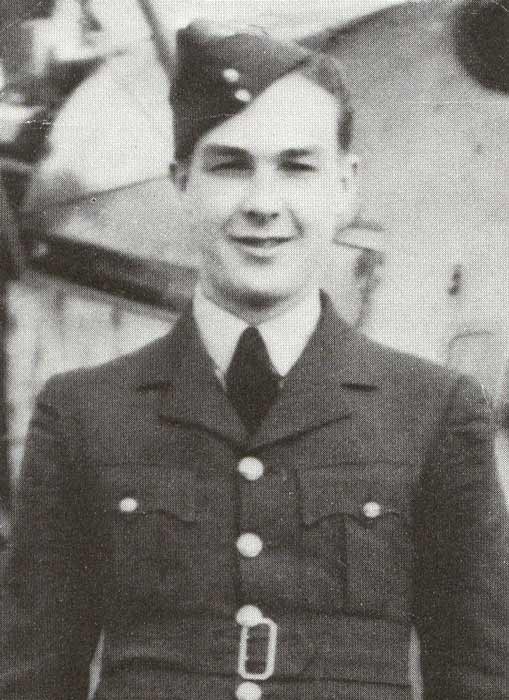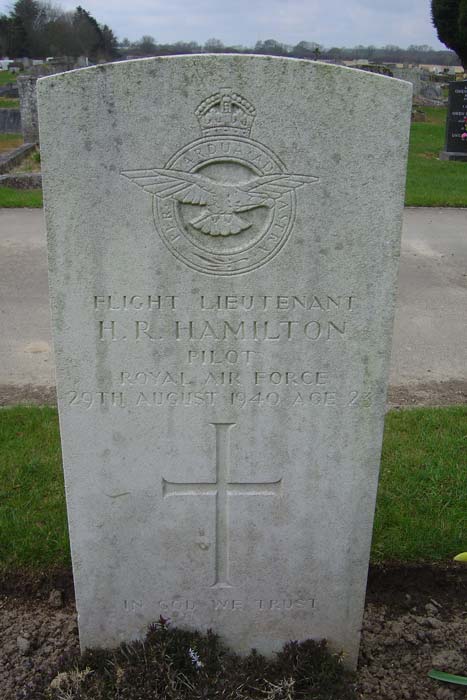Harry Raymond Hamilton
Biography / September 9, 2016
To view additional photos, click the photograph under "Image Gallery".
By Shari St. John
85 Squadron, Royal Air Force
Harry Raymond Hamilton – nicknamed “Hammy” – was born in Oak Point, Kings Country in New Brunswick on May 15, 1917.
A serious child, he grew up to be an easy-going individual who was often the brunt of light-hearted jokes. As a young man, Hamilton became a sub-contractor, wiring homes. With flexible work hours, Hamilton took up flying lessons as a hobby and his instructor, Fred Hartwick, often praised him by saying he was an “exceptional” pilot. With knowledge of flying and an interest in taking part in the war effort, Hamilton sailed to England in 1936 where he obtained a short service commission with the Royal Air Force (RAF).
Initially, Hamilton was posted to No. 3 Flying Training School in Grantham on January 11, 1937. This posting began a series of moves, as Hamilton then joined 46 Squadron at Digby that August. In early 1940, Hamilton flew with 611 Squadron, before his final posting to 85 Squadron on May 25 as Flight Commander flying Hurricane Mark I fighter aircraft.
On July 30, during the Battle of Britain, he led A Flight on a convoy patrol during which he and his wingman chased two German Messerschmitt (Me) 110 fighters. While one enemy fighter fled, the other was shot down and the young Canadian was credited with half the victory. The next encounter with enemy aircraft took place on August 18. In a series of massive air battles wherein the Luftwaffe and the RAF suffered 96 and 50 aircraft (respectively) damaged or destroyed. At approximately 5 p.m. that day, 12 fighters from 85 Squadron headed towards Canterbury, England, to search for enemy bombers and their escorts.
Upon finding the German bombers, the Allied pilots saw two levels of German fighters flying above. Hamilton and his wingman dove to engage the bomber force. While he fired at a Heinkel (HE) 111, his wingman appeared to collide with the enemy bomber. Hamilton stayed with the bombers, weaving away from the German fighters. Selecting a target, Ogilvie followed the enemy aircraft down to sea level firing at the way. The German pilot ditched his stricken aircraft and the crew was seen climbing into a dinghy. For his efforts that day, the Canadian pilot claimed one aircraft destroyed and a share in the destruction of another.
On August 29, Hamilton and the pilots of 11 other Hurricanes were once again sent out in the late afternoon to intercept what was thought to be 18 Heinkels. When 85 Squadron arrived at the location, however, an estimated 700 Messerschmitt fighters were flying above. The allied pilots recognized the trap they had entered, and Squadron Leader Peter Townsend, the commanding officer, was the first to face enemy fire. (Squadron Leader Townsend would later become widely known for his romance with Princess Margaret.)
Townsend survived the first Me 109 only to have another enemy fighter on his tail. Hamilton came to the rescue, getting behind the Me 109 and firing a seven second burst. The German pilot crashed into the English Channel. Two of the squadron’s Hurricanes were shot down and nearly all of the rest sustained some damage, but miraculously there were no fatalities. The first battle of the day was over, but 85 Squadron was in combat once again that night.
At 6 p.m., Townsend was leading the squadron once again when he noticed two stragglers at about 5,500 metres (18,000 feet). An unknown Spitfire and Hurricane were flying close when the Spitfire joined the formation of 85 Squadron. Townsend was cautiously watching the planes when the controller warned, “Bandits…in your vicinity.” Three Me 109s swept down on 85 Squadron. One of those pilots, Luftwaffe Oberleutnant Martin Rysavy, zeroed in on Hamilton and fired a quick burst of cannon and machine gun fire setting the Hurricane on fire. Townsend recalled feeling his heart sink as he watched Hamilton’s plane spiral to the earth in flames.
Flight Lieutenant Hamilton was 23 years old.
Two weeks after his death, a memorial service for Harry Raymond Hamilton was held in Oak Point Baptist Church. He was buried with full military honours in Folkstone’s New Cemetery in Kent County, England. His father eventually received condolences from many, including King George VI and Squadron Leader Townsend, who wrote that Hamilton had “died a hero’s death”.
Flight Lieutenant Hamilton’s name is inscribed on the Battle of Britain memorial in London, England, and his sacrifice was honoured with a monument placed near Oak Point Provincial Park in 1992.
Page details
- Date modified:

